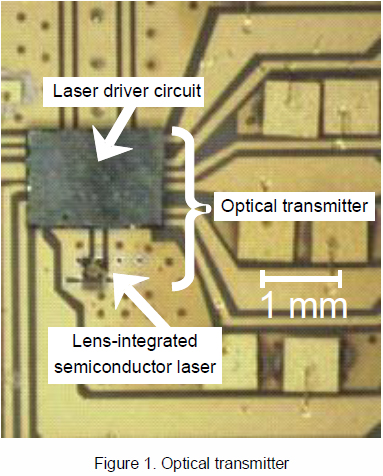Information contained in this news release is current as of the date of the press announcement, but may be subject to change without prior notice.
September 21, 2011
– Success in transmitting data at 25Gb/s,
2.5 times faster than conventional optical transmitters, over a distance of 100m –
Tokyo, September 21, 2011 – Hitachi, Ltd. (NYSE: HIT / TSE: 6501) today announced the development of a compact low-power-consumption optical transmitter for next-generation high-speed optical interconnects to be used in optical communication within and between IT equipment such as servers and storage systems installed in data centers. When the transmitter developed was used together with a previously developed receiver in transmission tests, a data transmission rate of 25 gigabit per second (Gb/s), 2.5 times that of conventional units, was achieved over a transmission distance of 100m. The optical transmitter developed employs a lens-integrated semiconductor laser diode (light source) and a laser-diode driver circuit based on complementary-metal-oxide-semiconductor (CMOS)*1 process technology. By optimizing the laser diode and circuit structures, the compact size and low power consumption were achieved.
The transmission experiment was conducted with one-channel, and the next step with view to practical application will be to develop a four channel module to achieve 100Gb/s optical transmission within and between IT equipment.
With the spread of broadband technology such as fiber-to-the-home (FTTH)*2, the volume of information transmitted over fiber-optic communications networks is expected to continue to increase. To support this, higher speeds are also being required in data transmission between and within IT equipment in data centers. With the conventional electrical wires, when the data transmission rate reaches 10Gb/s, signal degradation and loss become large and transmission over 1m becomes difficult. To overcome this, optical cables with less signal degradation and loss are beginning to be introduced. In order to conduct transmission within IT equipment however, the optical module needs to be reduced to the same size as the connector for the electrical wires, as well as reducing power consumption to save costs.
Hitachi previously developed a 10Gb/s optical transceiver, and through new technology enhancements, and using a compact semiconductor laser and CMOS circuit, has successfully achieved the development of a 25Gb/s transceiver.
Features of the compact optical transmitter developed are as described below.
A standard optical transceiver has a semiconductor laser which produces optical signals and an external lens, which focuses optical signal to reduce signal loss when connecting to an optical fiber. Hitachi has already developed a lens-integrated semiconductor laser operating at a transmission rate of 10Gb/s and achieved a compact semiconductor laser.
Aiming for a faster and lower power-consumption semiconductor laser, the optical resonator necessary to generate laser beams was optimized by reducing the length of the resonator by 25% while improving the optical reflectivity within the resonator thereby generating even faster optical signals with a lower electrical current. As a result, it was possible to increase the operating speed of the transmitter to 25Gb/s while at the same time reducing power consumption to about one half.
A low-power-consumption CMOS laser driver circuit was developed to enable the stable conversion (modulation) of the laser beam to optical signals even at a high speed of 25Gb/s.
When the conversion speed (modulation rate) at which the laser beam is modulated to optical signals reaches 25Gb/s, the differences in frequency characteristics per line increase due to variations in production, resulting in a degradation in laser-waveform quality. By adding a per line frequency controlling function to the driver circuit, good quality waveforms were able to be generated even at a speed of 25Gb/s. Further, by employing a CMOS circuit, a 30% reduction in power consumption and a 35% reduction in circuit area were achieved.
When the transmitter developed was used together with a previously developed receiver in transmission tests, a data transmission rate of 25 gigabit per second (Gb/s) over a distance of 100m was successfully achieved. Further, it was confirmed that per 1Gb/s, the transmitter operated at 6.3mW and the receiver operated at 2.7mW, resulting in a low power consumption of 9mW. The transmission experiments were performed using multi-mode optical fibers,*3 known for ease of connection with IT equipment, provided by Hitachi Cable, Ltd.
By achieving a reduced size, the technology developed can be applied to both optical transmissions within and between IT equipment. Further, whilst the transmission experiment was conducted with one-channel, in order to reach practical application a four channel module will be developed to achieve 100Gb/s optical transmission within and between IT equipment.
These results will be presented on September 21, 2011 at the 37th European Conference and Exhibition on Optical Communication, which will be held from September 18 to 22, 2011, in Geneva, Switzerland.
This work was supported in part by the “Next-generation High-efficiency Network Device Project,” contracted to the Photonics Electronics Technology Research Association (PETRA) by New Energy and Industrial Technology Development Organization (NEDO), Japan.

Hitachi, Ltd., (NYSE: HIT / TSE: 6501), headquartered in Tokyo, Japan, is a leading global electronics company with approximately 360,000 employees worldwide. Fiscal 2010 (ended March 31, 2011) consolidated revenues totaled 9,315 billion yen ($112.2 billion). Hitachi will focus more than ever on the Social Innovation Business, which includes information and telecommunication systems, power systems, environmental, industrial and transportation systems, and social and urban systems, as well as the sophisticated materials and key devices that support them. For more information on Hitachi, please visit the company's website at http://www.hitachi.com.